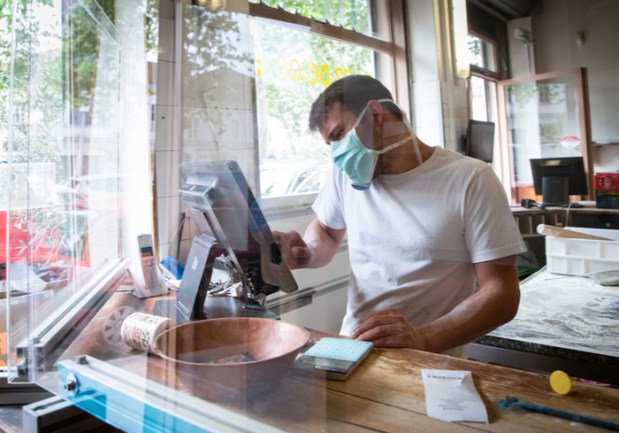SMBs Pivot And Change Business Models To Survive COVID-19

As the world grapples with the coronavirus pandemic, a situation no one has ever experienced before, everyone from kindergarten teachers to corporate executives has had to come up with creative approaches to get their jobs done and service the public. But no sector has been hit harder or had to brainstorm more for survival than the hospitality industry.
Restaurants, forced to close seating areas, hoped the public would order enough takeout and delivery to cover expenses. And although the most recent PYMNTS survey shows that more people than ever before started interacting digitally with restaurants — from 6 percent pre-pandemic to 20-plus percent in the thick of it — 93 percent report eating from restaurants less often than they did before the pandemic changed everyday life.
Suffering from lost revenues, some eateries went beyond menu items and family meals and tried to come up with ideas to help the public while also helping themselves.
Panera Bread, for instance, saw the increased demand for staples and decided to pivot a bit. While Panera still offered pickup and delivery of menu items, the chain also let customers place orders for bread, milk, yogurt, fresh produce and cheese.
Instead of going the grocery route, Waffle House emphasized its online hub for branded schwag, hoping customers would be attracted to novelty items and apparel as well as DIY versions of favorite menu items. People can order its specialty waffle mix, instant hash browns and coffee as well as shirts, socks, hats and more.
Bamboo Asia, a small restaurant chain operating throughout San Francisco’s financial district, saw quickly that the curbside pickup strategy wasn’t going to make up for its lost lunch crowd. The chain decided to develop ready-to-cook sous vide meal kits so families can have a DIY experience while also having a taste of Bamboo Asia.
Chick-fil-A went a similar route. In addition to curbside pickup, drive-thru service and delivery, the chain launched chicken parmesan meal kits so people could cook at home using its specialty chicken and other ingredients.
It’s not just restaurants that have been hit hard, however. Most small and medium-sized businesses (SMBs) are struggling and many aren’t sure they will even survive. A March PYMNTS survey of more than 200 SMB owners across numerous sectors and locations — including urban centers, small towns and big cities — asked people about their experiences before the pandemic and how it has changed since being in the thick of it.
The results show that nearly nine out of 10 of those SMBs (84 percent) have seen their revenues decline, with more than half (55 percent) reporting significant drops. Some 62 percent of construction and manufacturing firms said they experienced a major downturn in revenue. In addition, 60 percent of retail shops, personal services firms, coffee shops, bars and restaurants and fitness studios — shops that earn more than 75 percent of their sales in a physical store — saw sales freefall.
Further, 26 percent of SMBs surveyed said it was doubtful that they would survive the fallout from the pandemic. Some 33 percent said they weren’t sure; it would depend on when the lockdown eases and the extent customers return. Only 37 percent of SMBs remain confident that they will stay afloat.
The numbers can change any which way as the economy starts to slowly reopen and businesses gauge what the new normal will be like. Stay tuned.
